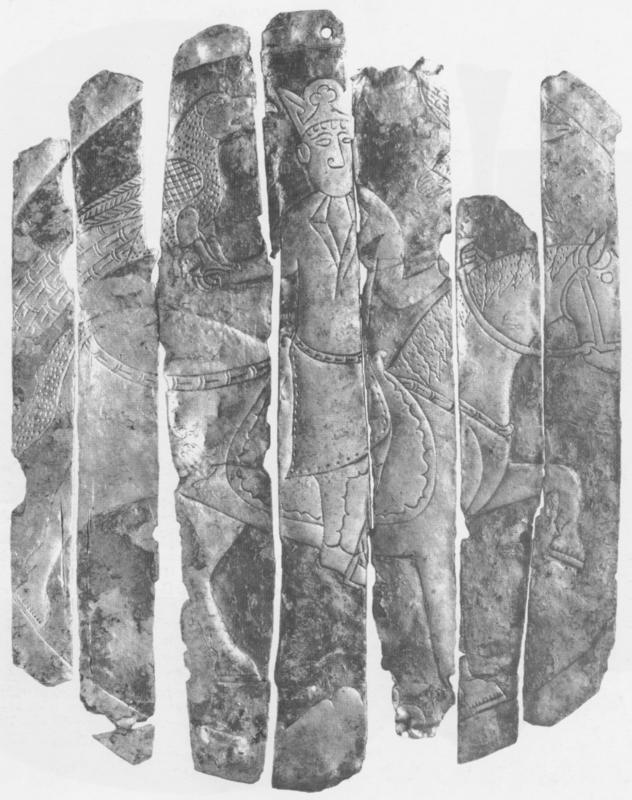Magyar Slit Dish with Mounted Hunter with Eagle from the Yuribey River
 A larger image of this Magyar Dish with Mounted Hunter with Eagle from the Yuribey River. |
 A larger image of this Magyar Dish with Mounted Hunter with Eagle from the Yuribey River. |
55. Plate with the image of a horseman with an eagle.
Silver, gilding. Diameter 20.3.
Hungarians before resettling in modern Hungary. IX century
Found on the river Yuribey (Vasilenko collection). Stored in the Yamalo-Nenets Regional Museum of Local Lore. Salekhard, inv. No. OF 1120/33.
The round plate was probably carved in ancient times along the contour of the central medallion from a silver dish (cf. cat. No. 54). The seekers cut the medallion into narrow strips to make fishing lures. Some areas were lost. The manufacturing technique and gilding of the background are the same as for cat. No. 53, 54.
Above the rider's head, there is a rough hanging hole. The rider and the horse are in many ways similar to the images on the bowl with the spearman (cat. No. 53). In particular, the human mouth is not shown. The horse's bit is carefully drawn, but there is no mouth either. The rider holds the reins in his left hand. On his right hand is a bird of prey, judging by the size of an eagle, although the legs and some details are not the same as those of the eagle. Above the left hand is a flying bird (duck?), which should become the prey of the hunter. This iconography of falconers is very well known in the countries of Islam during the 9th-13th centuries (for examples see Benda 1963). The rider has a crown on his head. A very similar horse hunter is depicted on a silver platter from the Hermitage found in the Kama region (Smirnov, 1909, ill. 157; Darkevich, 1976, pl. 56, 4; Marschak, 1986, Abb. 119). Both dishes belong to the group of early Hungarian vessels, which was most fully characterized by N.V. Fedorova (Fedorova, 1990). The curly brace motif in the blanket pattern and on the side seam of the boot was also used in a rougher form on the second dish with the hunter. The dressing of the belts and tail of the bird on both dishes is the same as on the wall painting of the 9th century Iraqi residence of the Caliphs of Samarra and on the Central Asian silverware of the X century (Marschak, 1986, S. 96-103, 345-347). With all the doubt that the mentioned vessels with figures of horsemen belonged to the same early Hungarian group, which also includes a bowl with a horse spearman (cat. No. 53) and a bowl with a lion (Smirnov, 1909, ill. 290; Darkevich, 1976, pl. 56, 3 ), it should be noted that on the plate from the Yuribey River is the least stylized horse and that there are so few specifically Hungarian elements on it that without other products, it would have been impossible to attribute it to the Hungarian circle, as D. Laszlo did in relation to the dishes with riders known to him (László, 1957, p. 185). This feature, as well as the closeness to the Middle Eastern samples dating back to the time after the 830s, allows us to think of a date within the second third of the 9th century, when the Hungarian style itself had just begun to take shape.
Source: Plate 55, "Treasures of the Ob Basin." Formika. 1996.228